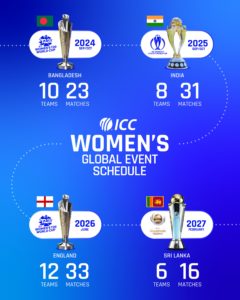Testing the water
1By Aiden McLaughlin
Rain was the winner in Hamilton on Saturday as the third and final women’s ODI between the White Ferns and Bangladesh at Seddon Park was abandoned after 26.5 overs.
It was the final international of a busy 2022 for the White Ferns who now return to their domestic teams for the Super Smash competition which starts on 23rd December.
From there, a squad will be selected for the eighth edition of the Women’s T20 World Cup, which takes place for the first time in South Africa, in February.
10 teams will play in 23 games over 15 match days in a tournament that starts less than a fortnight after the final of the first Women’s U-19 T20 World Cup, also being held in South Africa.
We already know that another four global events are scheduled for the women’s game over the next four years:
- Sept/Oct 2024: T20 World Cup in Bangladesh
- Sept/Oct 2025: ODI World Cup in India
- June 2026: T20 World Cup in England
- February 2027: T20 Champions Trophy in Sri Lanka
In August this year there was an announcement by the ICC regarding the inaugural women’s Future Tours Program for 2022-2025, which includes a total of 301 international matches outside of those global showpieces mentioned above, for:
- Australia
- Bangladesh
- England
- India
- Ireland
- New Zealand
- Pakistan
- South Africa
- Sri Lanka
- West Indies
The frustration of this FTP for many however, is that there are only seven Test matches included, versus 135 ODI’s and 159 T20I’s. England have the most Tests, with five, followed by Australia (four), South Africa (three) and India (two). Since the first in 1934, played between England and Australia, there have been a total of 144 women’s Tests, which are held over four days.
Penny Kinsella played six of those Test matches for New Zealand, all at home; a three match series against Australia in 1990, two matches versus England in 1992 and a Test against India in 1995.
“We were set up for it, because we were actually playing multi-innings format in our club cricket, and so the concept around building an innings, strategically bowling, and bowlers having longer spells, was part of what we wanted to do. I’m not saying that T20I’s and ODI’s aren’t strategic, but [the longer format] is a different way of looking at things. It’s about endurance and being able to test yourself to a different kind of limit.”
“You see people in Test matches now being able to leave a ball because it’s part of that challenge whereas you can’t do that in T20, it’s a different type of game,” says Kinsella.
One of her strongest memories is from her last test, against India, where Kinsella came in at 237-2 in the first innings.
“I pretty much spent a whole day in my pads because I was batting number four and our openers and our number three did very well. You couldn’t do that in another format. How do you deal with that kind of challenge? It’s a real mental test.”
“You know there’s no respite. You’ve got to stay in and if people are bowling at you, you’ve just got to take it.”
The FTP announcement came on the back of comments from Greg Barclay, the independent chair of the ICC, in June this year where he said:
“I can’t really see women’s Test or long-form cricket evolving at any speed at all. That’s not to say they can’t choose to play Test cricket, but I don’t really see that as part of the landscape moving forward to any real extent.”
A few weeks after Barclay’s comments, there was a one-off Test between England and South Africa at Taunton and in the build-up, England captain Heather Knight and vice-captain Nat Sciver both had their say.
“I think it’s quite a dangerous message to send that women shouldn’t be playing what is seen as the pinnacle of the game. I’m sure it [Barclay’s comments] wasn’t that well thought through. We shouldn’t limit what women’s cricket should be, and can do,” said Knight while Brunt said “It was a bit of a surprise, considering our most recent Test [against Australia] in Canberra was played the way it was. If anything, you’d have thought that would keep the format going.”
Recently retired White Fern Katey Martin played one Test for New Zealand, away against India in 2003, aged just 18.
“It was a pretty amazing experience. We had something like 15,000 fans that came into this private ground in Vapi. When I was young we played two day cricket in club cricket. I think it was a mandatory declaration after 60 overs of the first innings, so it meant that although the first innings wasn’t long, you were able to apply yourself longer at the crease which helped going into that Test match.”
“You were able to really break the game down into sessions and there was quite good intensity when you were working over a player in those sessions, which was a lot different to, say, a one-day game. I felt that tactically it just meant that you had to be a little more on, around how you would set your fields and how you would plan and be consistent in what you were trying to do,” says Martin.
The Canberra Test between Australia and England was part of the multi-format women’s Ashes contested in January and February this year. Three T20I’s kicked off the Ashes, followed by the Test, with three ODI’s being contested to close out proceedings.
After losing the toss, Australia made 337-9 declared, and England replied with 297 all out. With no play possible after lunch on day three, Australia made 216-7 in the second innings, before declaring to set England a total of 257 from 48 overs.
Heading into the last hour of play, 17 overs were left and England needed 104 runs with eight wickets in hand. That became 39 runs needed from 7.3 overs when Sciver became the four English wicket to fall and from there another five wickets quickly fell to leave England needing 13 runs from 2.1 overs and just one wicket remaining. England shut up shop, scoring just one more run, and Australia failed to get the last wicket meaning the match was drawn. It was a huge hit with viewers.
No words. We have witnessed one of the greatest games in Test history. @AusWomenCricket & @ECB_cricket take a bow. A draw seems unfair, but both sides at different points in the game deserved a win.
GIVE THE WOMEN MORE TESTS.#Ashes https://t.co/1vP03SGlrl
— Holly Ferling (@Holly_Ferling) January 30, 2022
Of course not every test will be so exciting. But does that mean that an opportunity to engage with fans and provide more women’s Tests should be discarded so easily? Many of the playing nations simply can’t afford it, so with that being the case, if the ICC can consistently organise white ball global events for the women’s game, how about testing the water with Test matches involving a Rest of the World team?
https://twitter.com/Womble101/status/1559478111385063425
Ok, so this tweet was wishful thinking, but does it really stretch the imagination that much? How about Australia host a one-off test of this nature as a minimum during their summer, while England do the same during their summer? If the ICC are reluctant to do it as a standalone game, then how about making it a multi-format series, like the Ashes? That would perhaps allay fears over attendance/viewer numbers for the longer form, as well as help mitigate the costs associated with staging Test cricket. Perhaps the Rest of the World side is solely made up of players from nations where there is no Test cricket scheduled currently, to really showcase the best of the rest? Perhaps, more realistically at first, it’s a mixture of all nations.
I appreciate that we have the FTP now so there are less gaps in the calendar. There are also more domestic women’s T20 leagues around the world, as well as The Hundred. But for the best players, the players that would be playing in these Tests, cricket is now their job. As full time professionals, they are used to the travel, the amount of games; and I’m guessing they would love to be involved and test their games.
The longer format of the game isn’t played domestically, so can we be sure that those playing Test cricket will be able to adapt; play more patient innings, bowl more overs, set different fields etc? I think you’d be hard pushed to argue that the very best players wouldn’t – in fact, I think the very best would thrive given the opportunity.
Imagine the likes of Sophie Devine and Sophie Bates retiring one day and being unable to say that they played any Test cricket during their illustrious careers? That just seems ridiculous.
“It was a special moment when you wear your baggy black cap and the knitted white jumper. You just felt like you were more of the history of New Zealand cricket; that’s not lessening the white ball game, but it’s the traditional game that everybody loves to play,” says Katey Martin.
Women’s cricket is heading in the right direction, both domestically and internationally, but there’s still plenty of scope to do better. Is it fair to say, like Greg Barclay did, that “If you look at the way cricket is going there is no doubt that white ball is the way of the future” ? To be fair, I think it is, but that doesn’t mean that Test match cricket for women can’t play a bigger part in that future – it needs some imagination as to how it would work, but I think it could.
The White Ferns will be gaining a whole new raft of supporters over the coming years with so much free to air cricket coming our way here in New Zealand. Yes, any new ICC events like this are likely to remain behind a paywall, as are their T20 and ODI formats, but wouldn’t it be good if female cricketers in this country could realistically aspire to play some sort of Test cricket, even if it wasn’t immediately for New Zealand? Like so many first steps, it just needs someone to show some faith and invest some cash. Over to you ICC.
Follow Aiden on Twitter


Absolutely!!!